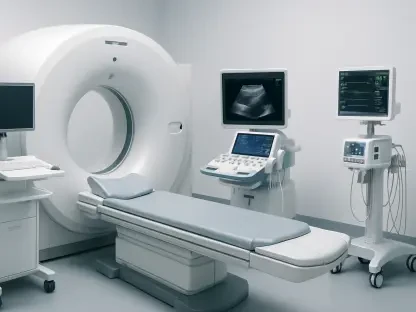As artificial intelligence continues to reshape industries worldwide, its potential to revolutionize healthcare stands out as both a beacon of hope and a source of concern, particularly in high-stakes areas like cancer diagnostics where precision can mean the difference between life and death. The promise of AI-driven tools to enhance patient outcomes through faster, more accurate diagnoses is tempered by significant challenges. Healthcare providers, regulators, and investors are grappling with the question of how to integrate these technologies into medical practice without compromising safety or trust. The journey toward widespread adoption is not merely a matter of innovation but hinges on demonstrating consistent, verifiable results that can withstand scrutiny. This delicate balance between technological advancement and empirical validation forms the crux of the ongoing discourse surrounding AI’s role in transforming healthcare systems globally.
Challenges in AI Adoption for Medical Applications
Building Reliability for Clinical Use
The healthcare sector operates under a unique set of constraints where the margin for error is virtually nonexistent, making the integration of AI technologies a slow and deliberate process compared to other industries. Unlike sectors where unproven innovations might gain traction based on potential, doctors and insurers prioritize real-world outcomes over speculative promises. This demand for reliability stems from past setbacks, such as AI models designed to predict genetic mutations that exhibited disappointingly low sensitivity, raising doubts about their practical utility. These early failures highlight the critical need for robust validation processes to ensure that AI tools can deliver consistent results in diverse clinical settings. Without such assurances, skepticism among healthcare professionals remains a formidable barrier, slowing the pace at which these technologies can be embraced as standard tools in patient care.
Transparency as a Cornerstone of Trust
Another significant hurdle in the adoption of AI within healthcare lies in the opacity of many complex models, which often leaves clinicians unable to understand or trust the reasoning behind specific outputs. When medical professionals cannot decipher how an AI system arrives at a diagnosis or recommendation, their confidence in the technology wavers, hindering its practical application. Simpler, explainable models, such as decision-tree approaches for classifying breast tumors with over 90% accuracy, offer a compelling alternative by clearly outlining the factors influencing their conclusions, like lymph node involvement. This transparency not only bolsters trust among practitioners but also aligns with emerging regulatory expectations in regions like Europe and the U.S., where auditability is becoming a prerequisite for approval. Bridging this gap through explainable AI could prove instrumental in accelerating acceptance across the medical community.
Pathways to Successful Integration
Demonstrating Tangible Outcomes
For AI to transition from experimental pilot projects to widespread clinical use, the focus must shift toward producing demonstrable outcomes that address lingering concerns about reliability and effectiveness in critical fields like oncology. Successful integration depends on the ability to trace errors back to their source, allowing for continuous improvement and accountability in AI systems. This meticulous approach to validation can help transform promising trials into established practices, particularly when supported by progressive legislation that prioritizes patient safety. The emphasis on empirical evidence over mere potential ensures that healthcare providers can rely on these tools without fear of compromising care quality. As stakeholders push for detailed performance metrics, the path forward becomes clearer, paving the way for AI to become an integral part of medical decision-making processes.
Balancing Innovation with Caution
The healthcare AI landscape is marked by a palpable tension between enthusiasm for innovation and the necessity for caution, as evidenced by significant venture funding and the active involvement of major tech players in areas like medical imaging. While substantial investments signal strong market confidence in AI’s capacity to redefine patient care, financial backing alone cannot guarantee success without concrete evidence of benefits. The consensus among stakeholders is that while the potential for transformation is immense, the journey toward becoming a cornerstone of medical practice requires a careful balance of creativity and rigorous testing. This duality reflects the broader industry trend of tempering excitement with accountability, ensuring that advancements do not outpace the frameworks needed to protect patients. By prioritizing transparency alongside technological progress, the sector can address adoption challenges and build a foundation of trust.
Reflecting on Progress and Future Steps
Lessons from Past Efforts
Looking back, the journey of AI in healthcare has revealed critical lessons about the importance of validation, as early models often fell short of expectations due to insufficient testing and unclear methodologies. Instances where AI failed to deliver reliable predictions in genetic mutation analysis served as stark reminders of the risks associated with hasty deployment. These experiences underscored the necessity for thorough, evidence-based approaches that could withstand the rigors of clinical environments. Reflecting on those challenges, it became evident that trust was not a given but had to be earned through consistent performance and open communication about system limitations. Such retrospection provided invaluable insights into how far the field has come in prioritizing patient safety over speed.
Charting the Road Ahead
Moving forward, the focus for AI in healthcare should center on creating actionable frameworks that blend technological innovation with empirical support, ensuring that tools are both cutting-edge and dependable. Emphasizing explainable models can serve as a bridge to wider acceptance, while regulatory efforts must continue to evolve to enforce accountability without stifling progress. Collaborative initiatives between tech developers, clinicians, and policymakers could foster environments where pilot successes scale effectively into routine practice. Additionally, sustained investment in research to refine error traceability will be crucial in addressing lingering doubts. By maintaining a steadfast commitment to transparency and proven outcomes, the healthcare sector can harness AI’s transformative potential while safeguarding the trust of all stakeholders involved in patient care.









